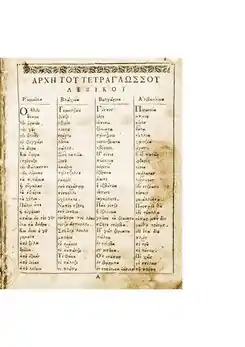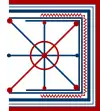Aromanian language
The Aromanian language (armãneashti, armãneashte, armãneashci, armãneashce or rrãmãneshti), also known as Macedo-Romanian or Vlach, is an Eastern Romance language, similar to Megleno-Romanian, Istro-Romanian and Romanian,[3] spoken in Southeastern Europe. Its speakers are called Aromanians or Vlachs (a broader term and an exonym in widespread use to define Romance communities in the Balkans). Some scholars, mostly Romanian ones, consider Aromanian a dialect of Romanian.
| Aromanian | |
|---|---|
| armãneashti, armãneashte, armãneashci, armãneashce, rrãmãneshti | |
| Native to | Greece, Albania, North Macedonia, Bulgaria, Romania, Serbia |
| Region | Balkans |
| Ethnicity | Aromanians |
Native speakers | estimated 210,000 (2018)[1] |
Early form | Common Romanian[2]
|
| Latin (Aromanian alphabet) | |
| Official status | |
Recognised minority language in | |
| Language codes | |
| ISO 639-2 | rup |
| ISO 639-3 | rup |
| Glottolog | arom1237 |
| ELP | Aromanian |
| Linguasphere | 51-AAD-ba |
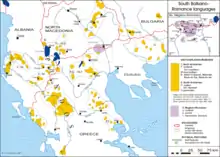 | |
| Part of a series on |
| Aromanians |
|---|
 |
|
| Eastern Romance languages |
|---|
|
Vulgar Latin language Substratum Thraco-Roman culture |
| Romanian |
|
| Aromanian |
|
| Megleno-Romanian |
|
| Istro-Romanian |
|
Aromanian shares many features with modern Romanian, including similar morphology and syntax, as well as a large common vocabulary inherited from Latin. An important source of dissimilarity between Romanian and Aromanian is the adstratum languages (external influences); whereas Romanian has been influenced to a greater extent by the Slavic languages, Aromanian has been more influenced by Greek, with which it has been in close contact throughout its history.
Geographic distribution
Aromanian is native to Albania, Bulgaria, Greece, North Macedonia, Romania and Serbia. In 2018, it was estimated that Aromanian had 210,000 native speakers, of which 50,000 were in Albania, 9,800 in Bulgaria, 50,000 in Greece, 50,000 in Romania and 32,000 in Serbia.[1]
Official status
Aromanian has a degree of official recognition in North Macedonia, where it is taught as a subject in some primary schools. In North Macedonia, Aromanian speakers also have the right to use the language in court proceedings. Since 2006, Aromanian has had the status of a second official municipal language in the city of Kruševo,[4] the only place in the world where Aromanian has any kind of official status apart from general state recognition.
Apart from North Macedonia, the Aromanians are also recognized in Albania as a national minority.[5]
History
Aromanian is similar to Romanian; its greatest difference lies in vocabulary. There are far fewer Slavic words (mostly Bulgarian, Macedonian, and Serbian) in Aromanian than in Romanian, and many more Greek words – a reflection of the close contact of Aromanian with Greek through much of its history. Loanwords of Greek origin were already present in Vulgar Latin, before the Roman Empire expanded into the Balkan region. Although there are fewer Slavic words in Aromanian, Aromanians are still surrounded by Slavic speakers in Bulgaria, North Macedonia, and Serbia, and Slavic loanwords are increasing.
It is generally considered that sometime between 800 and 1,200 years ago, Vulgar Latin spoken in the Balkan provinces of the Roman Empire, which is also known as Proto-Eastern Romance, broke up into four languages: Romanian, Aromanian, Megleno-Romanian and Istro-Romanian. A possible origin for Aromanian is that in the same way standard Romanian is believed to be descended from the Latin spoken by the Getae (Dacians [Daco-Thracians] and Roman settlers in what is now Romania), Aromanian descended from the Latin spoken by Thracian and Illyrian peoples living in the southern Balkans (Epirus, Macedonia and Thrace).
Greek influences are much stronger in Aromanian than in other Eastern Romance languages, especially because Aromanian has used Greek words to coin new words (neologisms), especially within Greece, while Romanian has based most of its neologisms on French. However, there has also been an increasing tendency for Aromanian-speakers outside of Greece to borrow terms from Romanian, due to the shared alphabet and contact with Romanian over the Internet, where Romanian-language material is much more available than it is in Aromanian.
With the arrival of the Turks in the Balkans, Aromanian also received some Turkish words. Still, the lexical composition remains mainly Romance.
Dialects
Aromanian is generally described as having three main dialects: Fãrshãrot, Grãmustean and Pindean.
It has also several regional variants, named after places that were home to significant populations of Aromanians (Vlachs); nowadays located in Albania, North Macedonia and Greece. Examples are the Moscopole variant (from the Metropolis of Moscopole); the Muzachiar variant from Muzachia in central Albania; the variant of Bitola; Pilister, Malovište (Aromanian: Mulovishti), Gopeš (Aromanian: Gopish), Upper Beala; Gorna Belica (Aromanian: Beala di Suprã) near Struga, Krusevo (Aromanian: Crushuva), and the variant east of the Vardar river in North Macedonia.
An Aromanian dictionary currently under development can be found on wiktionary.
Standardization efforts
The Aromanian language is not standardized. However, there have been some efforts to do so. Notable examples include those of Matilda Caragiu Marioțeanu,[6] Tiberius Cunia[7] and Iancu Ballamaci.[8]
Phonology
Aromanian exhibits several differences from standard Romanian in its phonology, some of which are probably due to influence from Greek or Albanian. It has spirants that do not exist in Romanian, such as /θ, ð, x, ɣ/. Other differences are the sounds /dz/ and /ts/, which correspond to Romanian /z/ and /tʃ/, and the sounds: /ʎ/, final /w/, and /ɲ/, which exist only in local dialects in Romanian. Aromanian is usually written with a version of the Latin script with an orthography that resembles both that of Albanian (in the use of digraphs such as dh, sh, and th) and Italian (in its use of c and g), along with the letter ã, used for the sounds represented in Romanian by ă and â/î. It can also be written with a modified Romanian alphabet that includes two additional letters, ń and ľ, and rarely with a version of the Greek script.
Consonants
| Labial | Dental/ Alveolar |
Post- alveolar |
Palatal | Velar | Glottal | |||
|---|---|---|---|---|---|---|---|---|
| Stop | voiceless | p | t | c | k | |||
| voiced | b | d | ɟ | ɡ | ||||
| Affricate | voiceless | t͡s | t͡ʃ | |||||
| voiced | d͡z | d͡ʒ | ||||||
| Fricative | plain | voiceless | f | θ | [ç] | x | (h) | |
| voiced | v | ð | [ʝ] | ɣ | ||||
| sibilant | voiceless | s | ʃ | |||||
| voiced | z | ʒ | ||||||
| Nasal | m | n | ɲ | |||||
| Trill | r | |||||||
| Approximant | lateral | l | ʎ | |||||
| central | j | w | ||||||
Vowels
| Front | Central | Back | |
|---|---|---|---|
| Close | i | ɨ | u |
| Mid | e | ə | o |
| Open | a |
- Two vowel sounds /ɨ, ə/ are both represented by one grapheme; ã.
Orthography
The Aromanian alphabet consists of 27 letters and 9 digraphs.[11][12][13]
| Letter | Name[14] | Pronunciation (IPA) | Notes |
|---|---|---|---|
| A, a | a | /a/ | – |
| Ã, ã | ã | /ə/, /ɨ/ | For /ɨ/, "â" may be used |
| B, b | bã | /b/ | – |
| C, c | cã | /k/, /tʃ/, /x/ | /k/ when followed by "a", "o", "u" or a consonant (/x/ in some dialects); /tʃ/ when followed by "e" or "i" |
| D, d | dã | /d/ | – |
| Dh, dh | dhã | /ð/ | Used only for notation in particular accents where this phoneme is present, otherwise "d" is used |
| Dz, dz | dzã | /dz/ | – |
| E, e | e | /ɛ/ | – |
| F, f | fã | /f/ | – |
| G, g | gã | /ɡ/, /dʒ/, /ɣ/ | /ɡ/ before "a", "o", "u" or a consonant (/ɣ/ in some dialects); /dʒ/ before "e" and "i" |
| H, h | hã | /h/ | – |
| I, i | i | /i/ | – |
| J, j | jã | /ʒ/ | |
| K, k | ca | /c/ | before "e" or "i" only |
| L, l | lã | /l/ | – |
| Lj, lj | lj | /ʎ/ | Found in Macedonian Latin alphabet |
| M, m | mã | /m/ | – |
| N, n | nã | /n/ | – |
| Nj, nj | nj | /ɲ/ | Found in Macedonian Latin alphabet |
| O, o | o | /o/ | – |
| P, p | pã | /p/ | – |
| Q, q | kiu | /k/ | Used only in foreign words – "c" is normally used instead |
| R, r | rã | /r/ | – |
| Rr, rr | rrã | ? | Used only for notation in particular accents where this phoneme is present, otherwise "r" is used |
| S, s | sã | /s/ | – |
| Sh, sh | shã | /ʃ/ | – |
| T, t | tã | /t/ | – |
| Th, th | thã | /θ/ | Used only for notation in particular accents where this phoneme is present, otherwise "t" is used |
| Ts, ts | tsã | /ts/ | – |
| U, u | u | /u/ | – |
| V, v | vã | /v/ | – |
| W, w | dublã vã | /w/ | Used only in foreign words |
| X, x | csã/gzã | /ks/, /ɡz/ | Same pronunciation as found in English |
| Y, y | i greacã | /j/, /ɣ/ | /j/ before "e" and "i", /ɣ/ elsewhere |
| Z, z | zã | /z/ | – |
In addition, the digraph "gj" (/ɟ/ before "e" and "i") is used as well.
Grammar
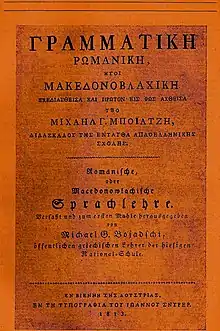
The grammar and morphology are very similar to those of other Romance languages:
- It has two grammatical numbers: singular and plural (no dual).
- It is a null-subject language.
- Verbs have many conjugations, including:
- A present tense, a preterite, an imperfect, a pluperfect and a future tense in the indicative mood, for statements of fact.
- An imperative mood, for direct commands.
- Three non-finite forms: infinitive, gerund, and past participle.
- Distinct active and passive voices, as well as an impersonal passive voice.
The Aromanian language has some exceptions from the Romance languages, some of which are shared with Romanian: the definite article is a clitic particle appended at the end of the word, both the definite and indefinite articles can be inflected, and nouns are classified in three genders, with neuter in addition to masculine and feminine.
Verbs
Aromanian grammar has features that distinguish it from Romanian, an important one being the complete disappearance of verb infinitives, a feature of the Balkan sprachbund. As such, the tenses and moods that, in Romanian, use the infinitive (like the future simple tense and the conditional mood) are formed in other ways in Aromanian. For the same reason, verb entries in dictionaries are given in their indicative mood, present tense, first-person-singular form.
Aromanian verbs are classified in four conjugations. The table below gives some examples and indicates the conjugation of the corresponding verbs in Romanian.[15]
| Conjugation | Aromanian (ind. pres. 1st sg.) | Romanian (ind. pres. 1st sg.) | Romanian (infinitive) | English |
|---|---|---|---|---|
| I | cãntu dau lucredzu |
cânt dau lucrez |
a cânta I a da I a lucra I |
sing give work |
| II | ved shed rrãmãn |
văd șed rămân |
a vedea II a ședea II a rămâne III (or a rămânea II) |
see sit stay |
| III | duc cunoscu ardu |
duc cunosc ard |
a duce III a cunoaște III a arde III |
carry, lead know burn |
| IV | mor fug ndultsescu |
mor fug îndulcesc |
a muri IV a fugi IV a îndulci IV |
die run away, flee sweeten |
Future tense
The future tense is formed using an auxiliary invariable particle "u" or "va" and the subjunctive mood.
| Aromanian fãrshãrot/ grãmushtean | Romanian (archaic) | Romanian (colloquial) | Romanian (modern) | English |
|---|---|---|---|---|
| u s'cãntu/ va s'cãntu | va să cânt | o să cânt | voi cânta | I will sing |
| u s'cãnts/ va s'cãnts | va să cânți | o să cânți | vei cânta | you (sg.) will sing |
| u s'cãntã/ va s'cãntã | va să cânte | o să cânte | va cânta | (s)he will sing |
| u s'cãntãm/ va s'cãntãm | va să cântăm | o să cântăm | vom cânta | we will sing |
| u s'cãntatsi/ va s'cãntats | va să cântați | o să cântați | veți cânta | you (pl.) will sing |
| u s'cãntã/ va s'cãntã | va să cânte | o să cânte | vor cânta | they will sing |
Pluperfect
Whereas in Romanian the pluperfect (past perfect) is formed synthetically (as in literary Portuguese), Aromanian uses a periphrastic construction with the auxiliary verb am (have) as the imperfect (aviam) and the past participle, as in Spanish and French, except that French replaces avoir (have) with être (be) for some intransitive verbs. Aromanian shares this feature with Meglenian as well as other languages in the Balkan language area.
Only the auxiliary verb inflects according to number and person (aviam, aviai, avia, aviamu, aviatu, avia), whereas the past participle does not change.[16]
| Aromanian fãrshãrot/ grãmushtean | Meglenian | Romanian | English |
|---|---|---|---|
| avia mãcatã/ avea mãcatã | vea mancat | mâncase | (he/she) had eaten |
| avia durnjitã/ avea durnjitã | vea durmit | dormise | (he/she) had slept |
Gerund
The Aromanian gerund is applied to some verbs, but not all. These verbs are:
- 1st conjugation: acatsã (acãtsãnd), portu, lucreadzã/lucreashce, adiljã/adiljeashce.
- 2nd conjugation: armãnã, cade, poate, tatse, veade.
- 3rd conjugation: arupã, dipune, dutse, dzãse, fatsi/featse, tradzi/tradze, scrie.
- 4th conjugation: apire, doarme, hivrie, aure, pate, avde.
Current situation
Media
The company Macedonian Radio Television (Macedonian: Македонска радиотелевизија, transliteration: Makedonska radiotelevizija) (MRT) produces radio and television broadcasts in Aromanian.
Radio Romania International has Aromanian service producing radio shows in Aromanian.[17]
Films produced in the Aromanian language include Toma Enache's I'm Not Famous but I'm Aromanian (2013)[18] and Pero Tsatsa's Carvanea Armaneasca (2015).[19]
Situation in Greece

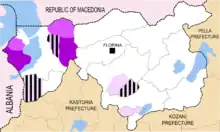
Even before the incorporation of various Aromanian-speaking territories into the Greek state (1832, 1912), the language was subordinated to Greek, traditionally the language of education and religion in Constantinople and other prosperous urban cities. The historical studies cited below (mostly Capidan) show that especially after the fall of Moscopole (1788) the process of Hellenisation via education and religion gained a strong impetus mostly among people doing business in the cities.
The Romanian state began opening schools for the Romanian-influenced Vlachs in the 1860s, but this initiative was regarded with suspicion by the Greeks, who thought that Romania was trying to assimilate them. 19th-century travellers in the Balkans such as W. M. Leake and Henry Fanshawe Tozer noted that Vlachs in the Pindus and Macedonia were bilingual, reserving the Latin dialect for inside the home.[20]
By 1948, the new Soviet-imposed communist regime of Romania had closed all Romanian-run schools outside Romania and, since the closure, there has been no formal education in Aromanian and speakers have been encouraged to learn and use the Greek language. This has been a process encouraged by the community itself and is not an explicit State policy. The decline and isolation of the Romanian orientated groups was not helped by the fact that they openly collaborated with the Axis powers of Italy and Germany during the occupation of Greece in WWII. Notably, the vast majority of Vlachs fought in the Greek resistance and a number of their villages were destroyed by the Germans.
The issue of Aromanian-language education is a sensitive one, partly because of opposition within the Greek Vlachs community to actions leading to the introduction of the language into the education system, viewing it as an artificial distinction between them and other Greeks. For example, the former education minister, George Papandreou, received a negative response from Greek-Aromanian mayors and associations to his proposal for a trial Aromanian language education programme. The Panhellenic Federation of Cultural Associations of Vlachs expressed strong opposition to the Parliamentary Assembly of the Council of Europe's recommendation in 1997 that the tuition of Aromanian be supported so as to avoid its extinction.[21] This recommendation was issued after pressure from the Union for Aromanian Language and Culture in Germany.[22] On a visit to Metsovo, Epirus in 1998, Greek President Konstantinos Stephanopoulos called on Vlachs to speak and teach their language, but its decline continues.
A recent example of the sensitivity of the issue was the 2001 conviction (later overturned in the Appeals Court) to 15 months in jail of Sotiris Bletsas,[23][24] a Greek Aromanian who was found guilty of "dissemination of false information" after he distributed informative material on minority languages in Europe (which included information on minority languages of Greece), produced by the European Bureau for Lesser Used Languages and financed by the European Commission. His conviction met with broad condemnation in Greece, where at least editorial compared the situation to the suppression of Kurdish and other minority languages in Turkey and noted the irony that some prosecutors in fact came from non-Hellenophone families that had once spoken Aromanian or Turkish.[25] Bletsas was eventually acquitted.[26]
Language samples
Fãrshãrot 1
Tatã a nostu tsi eshti tu tser,
si ayisiascã numa a Ta,
s’yinã amirãria a Ta,
si facã vrearea a Ta,
cum tu tser, ashã sh'pisti loc.
Pãnia a nostã, atsa di cathi dzuã, dãnu sh’azã,
sh‘ yiartãni amartiili a nosti,
ashe cum li yiãrtãm sh’noi a amãrtor a noci,
sh’nu ni du la pirazmo,
ma viagljãni di atsel rãu.
Cã a Ta esti amirãria sh'puteria,
a Tatãlui shi Hiljãlui shi a Ayiului Spirit,
tora, totãna sh’tu eta a etilor.
Amin.
Fãrshãrot 2
Tati a nost tsi esht tu tser,
s’ayiãsiaste numa a Ta,
s’zine amirãria a Ta,
si fache vrera a Ta,
cum tu tser, ashe sh'pisti loc.
Penia a noste, atsa di cathi dzue, denu sh’aze,
sh‘ yiartãni amartiãli a nosti,
ashe cum li yiãrtem sh’noi a amãrtor a noci,
sh’nu ni du la pirazmo,
ma viagãni di atsel reu.
Che a Ta esti amirãria sh'putera,
al Tati shi al Hiyiu shi al Ayiu Duh,
tora, totãna sh’tu eta a etãlu.
Amin.
Grãmushtean
Tatã a nostu, tsi eshtsã tu tseru,
s'ayiseascã numa a Ta,
s'yinã amirãriljea a Ta,
si facã vrearea a Ta,
cumu tu tseru, ashi sh'pisti locu.
Pãnea a nostã atsea di cathi dzuã dãnãu sh'adzã
sh'yiartãnã amãrtiile a noasti
ashi cum ilj yirtãmu sh'noi a amãrtoshloru a noshtsã.
Sh'nu nã du tu pirazmo,
Sh'aveagljinã di atsel arãulu.
Cã a Ta easti Amirãriljia sh'putearea
a Tatãlui shi Hiljãlui sh a Ayiului Duhu,
tora, totna sh tu eta a etilor.
Amen.
- The Lord's Prayer – source
Universal Declaration of Human Rights
Dina Cuvata translated Article 1 of the Universal Declaration of Human Rights as follows:
Tuti iatsãli umineshtsã s'fac liberi shi egali la nãmuzea shi ndrepturli. Eali suntu hãrziti cu fichiri shi sinidisi shi lipseashti un cu alantu sh si poartã tu duhlu a frãtsãljiljei.
Comparison with Romanian
The following text is given for comparison in Aromanian and in Romanian, with an English translation. The spelling of Aromanian is that decided at the Bitola Symposium of August 1997. The word choice in the Romanian version was such that it matches the Aromanian text, although in modern Romanian other words might have been more appropriate. The English translation is only provided as a guide to the meaning, with an attempt to keep the word order as close to the original as possible.
| Aromanian | Romanian | English |
|---|---|---|
| Vocala easti unã son dit zburãrea a omlui, faptu cu tritsearea sonorã, libirã sh'fãrã cheadicã, a vimtului prit canalu sonor (adrat di coardili vocali shi ntreaga gurã) icã un semnu grafic cari aspuni un ahtari son. | Vocala este un sunet din vorbirea omului, făcut cu trecerea sonoră, liberă și fără piedică, a aerului prin canalul sonor (compus din coardele vocale și întreaga gură) sau un semn grafic care reprezintă un atare sunet. | The vowel is a sound in human speech, made by the sonorous, free and unhindered passing of the air through the sound channel (composed of the vocal cords and the whole mouth) or a graphic symbol corresponding to that sound. |
| Ashi bunãoarã, avem shasili vocali tsi s'fac cu vimtul tsi treatsi prit gurã, iu limba poati si s'aflã tu un loc icã altu shi budzãli pot si sta dishcljisi unã soe icã altã. | Așa, avem șase vocale ce se fac cu aerul ce trece prin gură, unde limba poate să se afle într-un loc sau altul și buzele pot să stea deschise într-un soi sau altul. | This way, we have six vowels that are produced by the air passing through the mouth, where the tongue can be in one place or another and the lips can be opened in one way or another. |
| Vocalili pot s'hibã pronuntsati singuri icã deadun cu semivocali i consoani. | Vocalele pot să fie pronunțate singure sau împreună cu semivocale sau consoane. | The vowels can be pronounced alone or together with semivowels or consonants. |
Common words and phrases
| English | Aromanian |
|---|---|
| Aromanian (person) | (m.) Armãn/ rrãmãn, (f.) armãnã/ rrãmãnã |
| Aromanian (language) | Limba armãneascã/ limba rrãmãneascã; armãneashti/ armãneashte / armãneashci / armãneashce / rrãmãneshti |
| Good day! | Bunã dzua! |
| What's your name? | Cum ti chiamã? (informal) |
| How old are you? | Di cãtsi anji esht? |
| How are you? | Cumu hits? (formal) Cumu eshti?/ Cumu eshci? (informal) |
| What are you doing? | Tsi fats?/ Tsi adari? (popular) |
| Goodbye! | S'nã videmu cu ghine!/ Ghini s'ni videmu!/ Ghini s'ni vãdem! |
| Bye! | S'nã avdzãmu ghiniatsa!/ Sã s'avdzãm buniatsa! |
| Please. | Vã plãcãrsescu. (formal) Ti plãcãrsescu. (informal) |
| Sorry. | S'mi hãrãdzesht. |
| Thank you. | Haristo. |
| Yes. | Ye/ E. |
| No. | Nu. |
| I don't understand. | Nu adukiescu/ Nu akicãsescu. |
| I don't know. | Nu shtiu/ Nu shciu. |
| Where's the bathroom? | Yu esti tualetu? / Yu easti toaletlu?/ Yu easte tualetu? |
| Do you speak English? | Zburats / Grits - anglikiashti? / anglicheashce? |
| I am a student. | Mini est / estu un student/ Mine escu un student. |
| I am a good person. | Mini est / estu un om bun |
| You are beautiful. | Eshti mushat(ã)/ Eshci mushat(ã)/ Hi mushat(ã)/ Esht mushat(e). |
See also
- Aromanian alphabet
- Common Romanian
- Substrate in Romanian
- Balkan sprachbund
- Origin of the Romanians
- Thraco-Roman
- Daco-Roman
- Eastern Romance languages
- Romance languages
- Legacy of the Roman Empire
- Latin-Greek connection
References
Citations
- "Aromanian". Ethnologue. Retrieved 4 July 2022.
- Dindelegan, Gabriela Pană; Maiden, Martin, eds. (2013). The Grammar of Romanian. Oxford University Press. ISBN 9780199644926.
- "Romanian Language". britannica.com. Archived from the original on 2008-07-26. Retrieved 2018-05-17.
- Aromanians Archived March 1, 2007, at the Wayback Machine
- Stan, Liviu G. (19 October 2017). "Moment istoric: Aromânii, recunoscuți prin lege ca minoritate națională în Albania". InfoPrut (in Romanian).
- Caragiu Marioțeanu, Matilda, capitolul „Dialectul aromân”, Iorgu Iordan (coord.), Crestomație romanică, vol. III, partea I, București, Editura Academiei, 1968; online: Dialectul aromân, Avdhela Project – Library of Aromanian Culture.
- Cunia, Tiberius, Dictsiunar a limbãljei armãneascã, Constanța, Editura Cartea Aromână, 2010.
- Ballamaci, Iancu, Metoda aromână/vlahă, București, Predania, Avdhela Project – Library of Aromanian Culture, 2010, ISBN 978-606-8195-07-0.
- Béis, Stamatis (2000). Le parler aroumain de Metsovo: Déscription d'une langue en voie de disparition [The Aromanian language of Metsovo: Description of an endangered language] (Doctoral thesis) (in French). Université Paris 5 René Descartes.
- Caragiu Marioțeanu, Matilda (1997). Dicționar aromân (Macedo-vlah) [Aromanian Dictionary (Macedo-Vlach)]. Bucharest: Editura Enciclopedică. pp. xxviii–xxxvii.
- Aromanian alphabet at Omniglot
- Cunia, Tiberius. On the Standardisation of the Aromanian System of Writing Archived February 21, 2008, at the Wayback Machine
- "Bana Armâneascâ". Archived from the original on 2022-03-28. Retrieved 2021-04-06.
- "Bana Armâneascâ". Archived from the original on 2022-03-28. Retrieved 2021-04-06.
- Iancu Ianachieschi-Vlahu Gramatica armãneascã simplã shi practicã, Crushuva 1993, 1997; Μιχάλη Μπογιάτζη Βλαχική ήτοι μάκεδοβλαχική γραμματική Βιέννη, and Κατσάνης Ν., Κ. Ντίνας, 1990, Γραμματική της κοινής Κουτσοβλαχικής.
- Iancu Ianachieschi-Vlahu Gramatica simplã shi practicã, Crushuva 1993, 1997.
- "Radio Romania International".
- "Primul film realizat în limba aromână este povestea romantică a lui Toni Caramuşat". Observator (in Romanian). Retrieved 2021-03-09.
- Archived at Ghostarchive and the Wayback Machine: "Carvanea Armaneasca 2015 Subtitrare Romana. Film". YouTube.
- Weigand, in his 1888 Die Sprache der Olympo-Wallachen, nebst einer Einleitung über Land und Leute remarks: "By inclination, the Livadhiotes are zealous advocates of Greek ideas and would much prefer to be unified with Greece" (p.15).
- "ΠΟΠΣΒ – Διοικητικό Συμβούλιο" [POPSV – Board of Directors]. vlahos.xan.duth.gr (in Greek). 18 March 2004. Archived from the original on 12 August 2014.
- Baicu, Cornel (29 August 2003). ""Rumänien ist für uns eine zweite Heimat"" (in German). Deutsche Welle.
- "It's Not Greek Enough to Them". vlachophiles.net. 13 July 2001. Archived from the original on 2012-02-04. Retrieved 2007-01-17.
- "15-month prison sentence handed down to Mr Sotiris Bletsas for distributing information material financed by the Commission". European Parliament. 8 January 2002. Retrieved 2020-11-12.
- "Διασπορά αληθινών ειδήσεων" [Dissemination of real news]. iospress.gr (in Greek). February 10, 2001. Archived from the original on 3 March 2016. Retrieved 9 February 2016.
- Haggman, Johan (18 December 2001). "Minority Language Activist, Bletsas Found Not Guilty in Historic Court Decision". European Free Alliance – Rainbow. Archived from the original on 30 November 2007.
Bibliography
- Bara, Mariana. Le lexique latin hérité en aroumain dans une perspective romane. Munich: Lincom Europa, 2004, 231 p.; ISBN 3-89586-980-5.
- Bara, Mariana. Limba armănească: Vocabular şi stil. Bucharest: Editura Cartea Universitară, 2007, ISBN 978-973-731-551-9.
- Berciu-Drăghicescu, Adina; Petre, Maria. Şcoli şi Biserici româneşti din Peninsula Balcanică: Documente (1864–1948). Bucharest: Editura Universităţii, 2004.
- Capidan, Theodor. Aromânii, dialectul Aromân. Academia Română, Studii şi Cercetări, XX 1932.
- Caragiu Marioțeanu, Matilda. Dicționar aromân (Macedo-vlah). Bucarest: Editura Enciclopedică, 1997.
- Friedman, Victor A. “The Vlah Minority in Macedonia: Language, Identity, Dialectology, and Standardization”, in Selected Papers in Slavic, Balkan, and Balkan Studies, eds. Juhani Nuoluoto, Martti Leiwo, & Jussi Halla-aho. Slavica Helsingiensa 21. University of Helsinki, 2001. online
- Gołąb, Zbigniew. The Arumanian Dialect of Kruševo, SR Macedonia. Skopje: MANU, 1984.
- Kahl, Thede. "Aromanians in Greece: Minority or Vlach-speaking Greeks?". Society Farsharotu. Archived from the original on 2007-08-08.
- Kahl, Thede. “Sprache und Intention der ersten aromunischen Textdokumente, 1731–1809”, in Festschrift für Gerhard Birkfellner zum 65. Geburtstag: Studia Philologica Slavica I/I, ed. Bernhard Symanzik. Münstersche Texte zur Slavistik, 2006, p. 245–266.
- Marangozis, John. An Introduction to Vlach Grammar. Munich: Lincom Europa, 2010.
- Markoviḱ, Marjan. Aromanskiot i makedonskiot govor od ohridsko-struškiot region: vo balkanski kontekst [Aromanian and Macedonian dialects of the Ohrid-Struga region: in Balkan context]. Skopje: Makedonska akademija na naukite i umetnostite, 2007.
- Pascu, Giorge. Dictionnaire étymologique macédoroumain, 2 vols. Iaşi: Cultura Naţionalâ, 1918.
- Rosetti, Alexandru. Istoria limbii române, 2 vols. Bucharest, 1965–1969.
- "The Little Prince" by Antoine de Saint-Exupéry in Aromanian. Njiclu amirārush. Translated by Maria Bara and Thede Kahl, ISBN 978-3-937467-37-5.
- Vrabie, Emil. An English-Aromanian (Macedo-Romanian) Dictionary. University, Miss.; Stratford, CT: Romance monographs, 2000.
- Weigand, Gustav. Die Sprache der Olympo-Wallachen, nebst einer Einleitung über Land und Leute. Leipzig: Johann Ambrosius Barth, 1888.
External links
- "Dictionary in Aromanian Language".
- Aromanian Language website
- Στα Βλάχικα – In Vlach: A website about the Vlach language in Greece
- Aromanian Swadesh list of basic vocabulary words (from Wiktionary's Swadesh list appendix)
- Aromanian basic lexicon at the Global Lexicostatistical Database
- Asterios Koukoudis: Studies on the Vlachs
- Greek Helsinki Human Rights Organization: Aromanians (Vlachs) in Greece
- Conjugation of verbs in Aromanian and Istro-Romanian Archived 2008-12-19 at the Wayback Machine
- Romanian and the Balkans, with some references to Aromanian
- Greek Vlach website
- Consiliul A Tinirlor Armanj – CTARM, webpage about Youth Aromanians and their projects
- Armans Association from Serbia
- Armans Cultural Association from Romania
- Η βλαχική γλώσσα στο γλώσσες και αλφάβητα του κόσμου
- EVANGHELU PI DUPI LUKA (The Gospel according to Luke in Aromanian).
